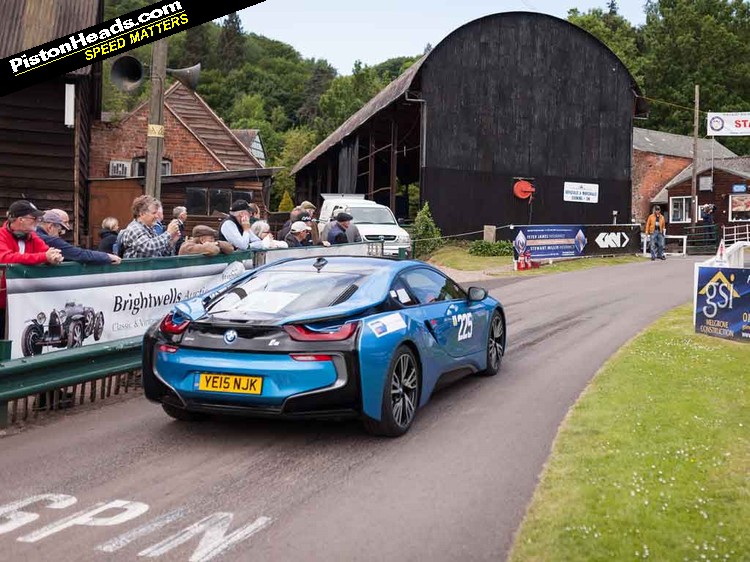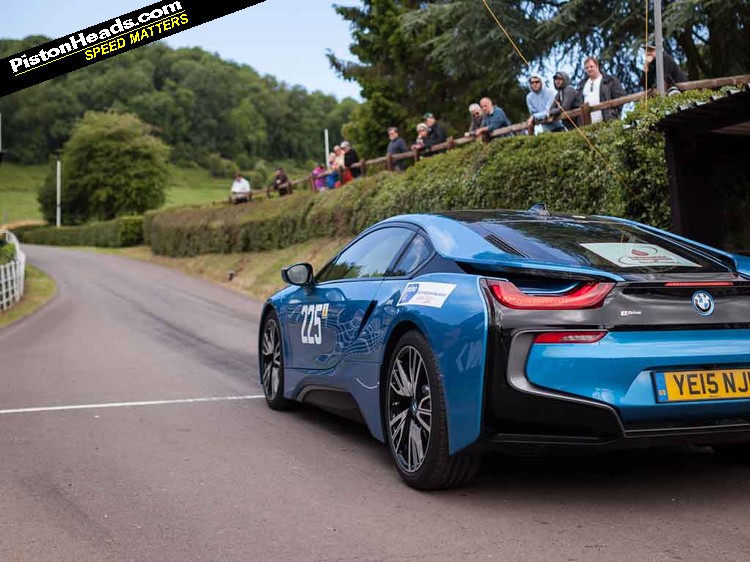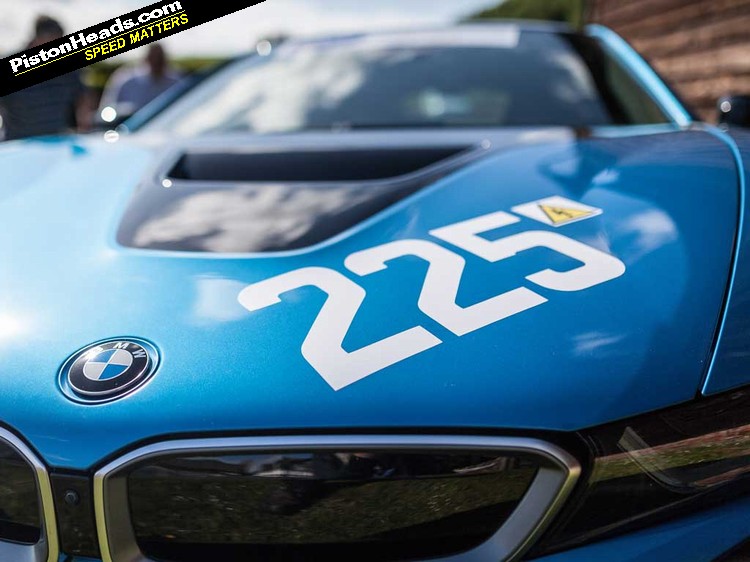
| 06-09-2015, 01:50 PM | #1 |
|
Brigadier General
 
1608
Rep 4,512
Posts |
Whelsley Walsh & BMW i8 in Class Z
 Here's the Hill Climb map:  Cool article from PistonHeads: Leaders Hillclimb Multi Car Challenge - BMW i8 Chance of a hybrid course record at Shelsley Walsh ... if Al can keep the i8 on the black stuff  The plan to run in the class for production cars over 2000cc has gone a little awry of late. We started off well with the Mercedes A45 AMG, but then the temptation of an Abarth 695 Biposto dropped us into the sub-2000cc category. 1,499cc turbocharged petrol engine or not surely the additional electric power of a BMW i8 would get us back among the larger engined production cars? Hybrid power put the i8 in a class of its ownHybrid power put the i8 in a class of its ownHowever, the powers that be at Shelsley Walsh decided the i8 should run in Class Z, which is specifically for hybrid and electric cars. It was a disappointment on one hand as we'd wanted to test the i8's mettle against established runners such as Porsche 911s, Subaru Imprezas and supercharged Lotus Elise and Exige variants. The upside is there was no previous class record for hybrid cars at Shelsley, so the Multi Car Hillclimb Challenge only had to keep it together to join a select group of record-holding drivers. Arriving on Saturday morning, there was little to do to the i8 other than give it a wipe over with a clean cloth and apply the usual championship stickers and ones for the NationalAssociation of Blood Bikes. There was one more sticker to add this time, though, thanks to new sponsor Primo, which provides multi-vehicle insurance policies. We were also prepared for the idiosyncratic way practice runs are allocated at Shelsley. If you are among the first 30 drivers in the queue to sign on, you're guaranteed three practice runs on the Saturday, plus your two competition drives on Sunday. Everyone else takes pot luck for an additional third practice run. Two power sources, four driven wheels... Two power sources, four driven wheels... We didn't manage this and nor were we prepared for the huge interest in the i8. Surrounded by petrol- and methanol-fuelled cars, the i8's petrol-electric hybrid set-up seemed to capture the imaginations of everyone we spoke to. The most common question was whether or not the car ran solely on electricity, which it can for up to 23 miles depending on the battery charge. There was also a lot of surprise at how quiet the car is from the outside. Our main concern was making sure there was sufficient charge in the battery to deliver the i8's full whack of 362hp. With the 131hp electric motor driving the front wheels and the 1.5-litre turbo triple powering the rears, 0-62mph comes up in 4.4 seconds, so the i8 looked good for getting off the line at Shelsley. This proved to be the case and it was remarkably consistent over the first 64-feet, recording identical 2.44-seconds for each timed run. Less consistent was the intervention of the DSC traction control system, which we decided to leave switched on due to the relatively narrow tyres and their hard rubber compound. On the road, the i8 feels brilliantly balanced, but into the 'Bottom S' at Shelsley, the BMW's front end would begin to understeer and that brought the DSC into play. Switching off the DSC only made the problem worse, so it was better to devise a driving style to work with the system as best as possible. To achieve this, we found avoiding the left-hand kerb at Bottom S and an earlier turn in for 'Top S' kept the DSC at bay. In the end, the first timed competition run proved the best at 35.27 for team-mate David Finlay as trying to be even smoother in the second run could only net 35.38 seconds. To put that in context, our best time in a Volkswagen Golf R last year at Shelsley was 34.95 seconds. Different tyres would make a massive improvement to the i8 for hillclimbing, but as a showroom fresh road car it acquitted itself well and deservedly now holds a class record. You can watch the run recorded on our Garmin Dash Cam 20.  (I bolded the i8 paragraph) Hot weather and even hotter action at Shelsley Walsh Blazing sunshine and huge crowds greeted a capacity list of competitors in the 'Best of British' hill climbing event at Shelsley Walsh over the weekend. A wide variety of sports, classic, saloon and racing cars took part in class events for the MSA British Hill Climb Championship, The Hill Climb Leaders Championship and the ever-popular Midland Hill Climb Championship. Fastest time of the day went to Southam driver Jos Goodyear with a blistering run of 23.03 seconds in his diminutive yet amazing supercharged 1340cc GWR Raptor racing car, appearing more like an oversized Scalextric car as it shot up the narrow course to thrill the 1000's of spectators. Wins for Jos Goodyear and reigning champion Scott Moran in the Top 12 run offs saw the points table positions remaining the same for the British Championship, with Tenbury Wells driver and Moran's co-driver, Alex Summers still leading the field as they head to Loton Park next weekend. Ben Tranter, from York, set a new class record with a time of 31.89 seconds driving his Vector TF93K in the Formula Ford Racing Car class. Reigning Midland champion Mike Turpin of Hereford took the honours with his Vauxhall VX220 in the Modified Production Car class while former champion Rob Stevens added to his points by winning the Sports Libre class in his Force SR4. Colin Satchell of Holsworthy, driving a Peugeot 205, took the 2 litre Modified Production class by two one-hundredths of a second from hard-charging Sarah Bosworth, of Sheffield, in her Lotus Elise, who also managed to spin the car on her final run. Other class wins came for Paul Jones in a Lotus Elise, Tony Bunker in a Nissan GTR, Allan Warburton in a Caterham 7, Charles Williams in an OMS SC1, Chris Aspinall in an Empire Wraith, Eynon Price in a Gould GR59 and Howard Savage-Jones in a Lola Colgan. Shelsley Specials, both pre war and post war, produced wins for Michael Sythes in the Freikaiserwagen and Peter Speakman in the Fisher Spyder Special, respectively. Motoring journalist David Finlay from Scotland, entered the very latest hybrid technology BMW i8 futuristic looking car and managed to record a best time of 35.267 seconds while John Marshall with his F430 Scuderia won the class for cars entered in the Ferrari Hill Climb Championship. One well-known face amongst the crowds was television presenter and motoring enthusiast Jon Bentley, of The Gadget Show, who commented: 'I came to Shelsley Walsh on occasion as a boy but to see the change in design and power of these current machines is simply amazing and their performance is truly breathtaking.' This coming weekend sees the return of the popular Shelsley Walsh Breakfast Club where people are invited to bring along their cherished cars and mingle with like-minded enthusiasts. Next hill climb event is the Reg Philips Trophy Meeting on the 4th July and the Vintage and Post Vintage Thoroughbreds on the 5th July.    
__________________
Last edited by 954Stealth; 06-09-2015 at 02:17 PM.. |
| 06-09-2015, 02:20 PM | #2 |
|
Brigadier General
 
1608
Rep 4,512
Posts |
The words of Mr. David Finlay:
"Driving up a difficult hillclimb course in £104,540 worth of supercar with your eyes half shut isn’t the best idea. I didn’t push it and recorded a modest opening time of 37.61 seconds. At least I now had some idea how a car I’d previously only driven the length of the M40 would behave on corners. Between that run and the second a few hours later I must have had dozens of conversations with interested spectators and fellow competitors about the i8, which was parked in a very prominent position in the paddock and looked particularly snazzy with its race numbers and the stickers showing allegiance to the Challenge’s new sponsor, Primo plc. Primo specialises in providing insurance for people who own several cars, and saw a synergy between that and our efforts to compete in as many different models as we can over the course of the season. I explained several times that the i8’s 1.5-litre turbo engine drives the rear wheels while an electric motor looks after the fronts, and that, yes, both were in operation at all times during the run. A surprising number of people thought it was using the electric motor only, which seemed odd to me because from the inside the car sounds very sporty at full throttle." "In fact, that sound is mostly artificial. From the outside, I’m told, the car is almost silent. A friend who went up the hill to take a picture of it got his camera out when the commentator announced that I was on the start line, and realised he’d missed his opportunity as he heard it swishing past. He was expecting to have some audible warning that it was accelerating out of the previous corner, but there simply wasn’t any. More awake than I’d been previously, I tried a lot harder on my second run and achieved a much more satisfying 35.53. At that pace, two things became apparent. First, the i8 feels a little like two cars joined together, since flooring the accelerator produces different reactions at different times from the two power sources. Second, the Dynamic Stability Control system kicks in early, no doubt because BMW uses fairly narrow tyres (215mm up front, 245mm at the rear) of what is in motorsport terms a very hard compound. I toyed with the idea of switching off DSC for Sunday’s competition runs, but felt it must be coming on for a good reason. I didn’t want to end up in a crumpled heap against a barrier, nor have to explain to BMW why the i8 would be coming back on a rescue lorry rather than under its own power." The tactic for the competition runs was to keep DSC switched on but stop it interfering by turning into corners as smoothly as possible. At the first attempt this worked quite well. There were still times when DSC felt as if it was trying to bring the car to a halt, but they were less serious than before and that run took 35.27 seconds. A small piece of history had been made. Although I had originally entered the i8 in the Road-Going Series Production class I was told it couldn’t run in that and would instead be shifted into Class Z for electric and hybrid cars, also known to witty fellows as the ‘milk float’ class. Nobody had ever run in this before and I was the only one doing it now, so by completing one competition run I had not only won the class but established a record for it. Well, that was nice, but I wanted to get into the 34s and on my final run I really went for it. The DSC avoidance tactic was developed further. At Bottom Ess, the second last corner on the hill, I avoided the concrete rumble strip on the inside and then turned in earlier than normal for the following Top Ess, which is not a good line in normal circumstances but it let me drive round on a constant radius. There was still some DSC intrusion, but less than on any of the previous runs." It didn’t work. I’d over-compromised. According to the split times I was three hundredths slower than before through that section and must have had a poorer exit because I crossed the finish line at 92mph rather than, as before, 93. I was also slightly slower on the lower part of the hill despite feeling that I’d been much faster, which is usually a sign that either you’ve run out of ideas or the car needs to be modified to get better times. The resulting 35.38 was a little disappointing, but it wasn’t a bad time and I quite enjoyed the run. The whole weekend had been a great experience and as a result of it I am now a Shelsley record holder, which until now is something reserved for my dreams. Proper dreams, I mean. Ones you have in bed, not while sitting in a car wearing a crash helmet when you’re supposed to be concentrating on your next run. Many thanks to everyone who came up to chat during the event and, if you’re enjoying the Challenge, please express this by making a donation to our chosen charity, the wonderful National Association of Blood Bikes. Our next outings will be at Loton Park on 13-14 June in a Vauxhall Corsa VXR and at Doune on 21-22 June in a Ford Fiesta ST with the Mountune performance kit. Do come and say hello. Al will be the one still trying to clear the last of the sand out of his armpits." |
|
Appreciate
0
|
| 06-09-2015, 03:50 PM | #3 |
|
Brigadier General
 
1608
Rep 4,512
Posts |
This better defines just what Class Z is in the Hill Climb Racing World; it's pretty interesting to me that i8s fit in to this category but I guess Z includes a lot of orphans from the other categories
Class Z: Period Defined Vehicles (Non-Rally) A-E inclusive with a side-valve engine block (commonly referred to as a Flathead) Chassis: Free Front Axle: Free Rear Axle: Free Transmission: Free Differential: Free Steering: Free Brakes: Free Engine: The engine block shall originally have been of a design commonly referred to as side-valve, valve-in-block, L-head, T-head, flathead, etc. of any age and capacity. Increase in capacity (swept volume) by any means shall be acceptable. Conversion to a form of partial or complete overhead valve configuration shall be acceptable. Aspiration by any means shall be acceptable including super- and turbo-charging. Any form of carburation or fuel injection shall be acceptable. Fuel: Any form of fuel shall be acceptable, including additives such as water and/or nitrous oxide, subject to the regulations and safety requirements of RAC Motor Sports Association “Blue Book”. Bodywork: Free, subject to the safety requirements of RAC Motor Sports Association “Blue Book”. Silencing: All vehicles shall comply with the Supplementary Regulations of the venue and with the requirements of the RAC Motor Sports Association “Blue Book” as administered by venue Clerk of the Course whose decision shall be final. https://www.msauk.org/The-Sport/Regulations |
|
Appreciate
0
|
Post Reply |
| Bookmarks |
|
|